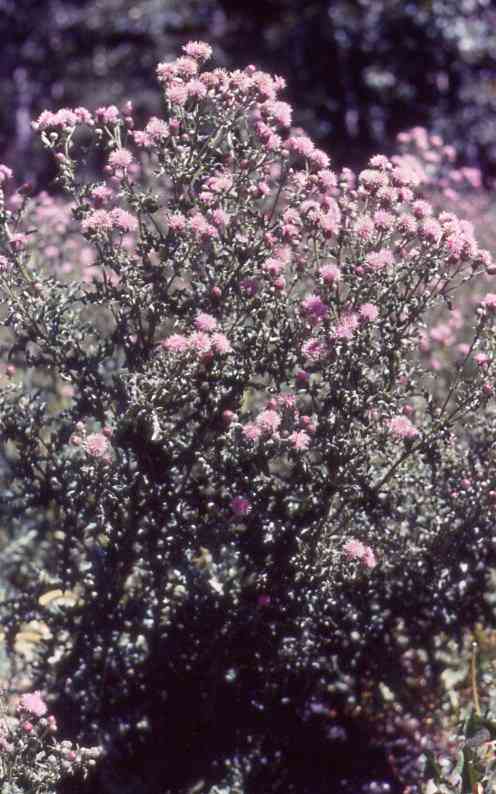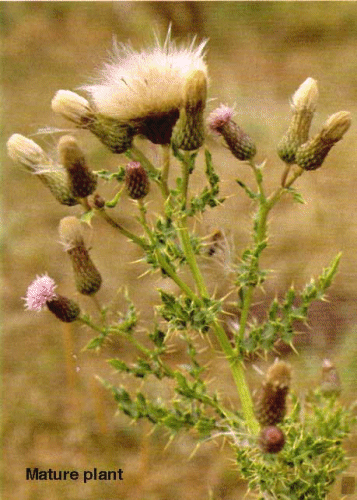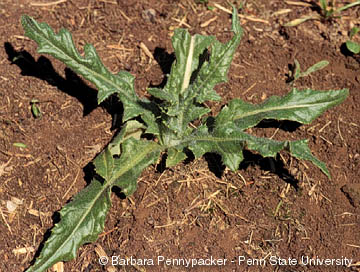Scientific Name: Cirsium
arvense
Classification:



Phylum or Division: Magnoliophyta
Class: Magnoliospida
Order: Asteridae
Family: Asteraceae
Subfamily:
Canada
thistle is a 2 to 5 foot tall herbaceous perennial with branched,
grooved and slender stems that become covered in hair as the plant
grows.
The roots are deep and wide spreading horizontal roots which enable
vegetative
spread by cloning. Alternately occurring lance shaped leaves are
green on
both sides with a slightly downy undersurface and edges that are deeply
lobed
with stiff yellowish spines on the leaf margins. The thistle is
dioecious, thus all flowers on it are either male or female.
Numerous
small, compact rose-purple or white flowers appear on the upper stems
from June
to Sept.-Oct. forming round, umbrella shaped clusters. The seeds
are
small (3/16 inch or 0.5 cm long), light-brown, smooth and slightly
tapered with
a tuft of tan hair loosely attached to the tip. Distinguishing
Canada
thistle from other thistles (Cirsium
spp.) can be achieved by noting its unique
traits of having deep-running perennial rootstocks, more slender stems,
and
small compact heads.
Original
Distribution: Cirsium
arvense is native
to southeastern
Mediterranean region. Some
sources also trace it back to southern Europe, western Asia and
northern
records of its
original distribution in its native habitat are unknown.
Current
Distribution: Canada
thistle is now widespread in all
between 37 and 58-59 degrees N. The only states in the US
that are
relatively free of Canada
Thistle are Texas, Oklahoma, Louisiana, Mississippi, Alabama,
Georgia, South Carolina and
Florida. In fact, Canada Thistle has a near
global distribution at the aforementioned latitudes in
the northern hemisphere
and at latitudes greater than 37 degrees S in the southern hemisphere
exclusive of
Africa, western and central Asia, northern
South Africa
Site
and Date of Introduction: Despite its
common name, the Canada thistle is native to
Europe and was
apparently introduced to
Cirsium
arvense was declared a noxious weed by the state of
Mode(s) of
Introduction: Though the
original mode of introduction is unknown, the Canada thistle is
currently spread through contaminated crop seed, feed, manure,
irrigation water
and wind. Canada thistle produces an abundance of bristly-plumed
seeds
which are easily dispersed by the wind. A single plant produces
an
average of 1500 seeds, and a maximum of up to 5300 seeds in some
records!
Multiple plants in one area produced an average of 100-64,300 viable
seeds/m2
in
Reason(s)
Why it has Become Established: The Canada
thistle does best in disturbed areas such as in overgrazed pastures,
old fields, waste places and along fence rows and roadsides. It can
also invade
sedge meadows and wet prairies from adjacent disturbed sites. The
preponderance of disturbed areas in the
The Canada
thistle has no natural enemies in its native habitat
and relatively few organisms have the potential to act as biological
control
agents in its nonnative habitats. Most
organisms
that would prey upon or utilize the Canada thistle are not adequately
synchronized with its life cycle to have a large impact or interaction
with
it. The few species that do interact or
harm the thistle include: Orellia
ruficauda (a seed head
predator), Ceutorhychus litura (a
stem-mining weevil) and Vanessa Cardui
(larval leaf-feeding Painted Lady Butterfly). In
moist areas in
Benefit(s):
Canada
thistles are regarded as a good source of nectar and pollen for
honey bees. American Indians purportedly used an infusion of its roots
for
mouth diseases and considered it to be useful as a tonic, diuretic and
astringent and that the young shoots and roots can be used in the same
ways as
asparagus, and were eaten in
Threat(s):
Canada
Thistles are found in virtually all crops, and are also found in
pastures and rangelands where it reduces feed used by grazers. Heavy infestations growing in pasture can
reduce native grass production by as much as 60 percent. The
prickly mature foliage is thought to
reduce productivity of pastures by deterring livestock from grazing and
thus
threatens both the agricultural and livestock based farming. It
also
serves as an alternate host for insects and pathogenic microorganisms
that
attack various crops. In the
Control
Level Diagnosis: This
species seems to fall under the highest priority of control due to
it's fecundity, the availability of habitat suitable for its growth and
the
success with which it out competes native and agricultural plants. The
monetary
loss it has already caused as well the increase in the abundance of
disturbed
ecosystems providing suitable habitat for invasion make it a species
that
requires serious eradication efforts.
Control
methods researched include using herbicides, agricultural
methods and mechanical methods. For instance, effective
control can
be achieved by using several broad-leaved herbicides that do not harm
grasses
as long as they are timed according to the reproductive cycle for
optimal
effectiveness. Fire early in the growing
season can actually increase sprouting and reproduction so prescribed
burns in
late spring are considered more effective.
Overall, biological control currently provides little or no
control of Canada thistle populations, although some agents weaken and
kill
individual plants. Most potential biological control organisms are not
adequately synchronized with Cirsium
arvense's life cycle in
DIfferent control methods are also required for different
levels of invasion and the sites they are invading. Canada
thistle should
be removed from high quality natural areas when it is first observed
since it
is very tenacious and difficult to control once established. In lower
quality
areas, management effort should be influenced by the extent of
invasion; greater
effort is warranted in areas that have new and/or small invasions which
are
more likely to be eliminated or contained.
References:
Nadeau, L. B. and W. H. Vanden Born. 1989. The root system of Canada thistle. Canadian Journal of Plant Science 69: 1199-1206.
O’Sullivan,
P. A., V.
C. Kossatz, G. M. Weiss, and D. A. Dew. 1982. An approach to estimating yield loss of barley due
to Canada thistle. Canadian
Journal of
Plant Science 62: 725-731.
O’Sullivan, P. A., G.
M. Weiss,
and V. C. Kossatz. 1985. Indices of competition for estimating
rapeseed yield loss due to Canada thistle. Canadian Journal of Plant Science 65: 145-149.
Schroeder,
D. 1980. The biological control of thistles. Biocontrol
News and Information 1:
9-26.
Thomas,
R. F., T. J. Tworkoski, R.C. French, and G.R. Leather. 1994. Puccinia punctiformis
affects growth and reproduction of Canada thistle (Cirsium arvense). Weed
Technology 8: 488-493.
Invasive Plants of the
http://www.invasive.org/eastern/biocontrol/17CanadaThistle.html
USDA Natural Resources and Conservation Service
http://plants.usda.gov/cgi_bin/plant_profile.cgi?symbol=CIAR4
The Nature Conservancy Element Stewardship Abstract
http://tncweeds.ucdavis.edu/esadocs/documnts/cirsarv.html
Washington
http://www.nwcb.wa.gov/weed_info/canadathistle.html
Illinois Nature Preserves Comission http://www.inhs.uiuc.edu/chf/outreach/VMG/cthistle.html
PCA Alien Plant Working Group
http://www.nps.gov/plants/alien/fact/ciar1.htm
Photo References:
http://members.rogers.com/mulligan4520/images/Comp.16,%20Canada%20thistle.JPG
Multi-stem
Plant Photo
http://members.rogers.com/mulligan4520/images/Comp.16,%20Canada%20thistle.JPG
http://cropsoil.psu.edu/Extension/LivingMulch/images/Canadian_thistle.jpg
(copyright, Barbara Pennypacker –